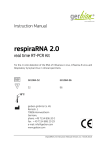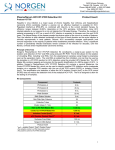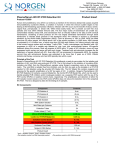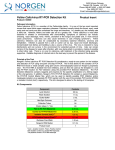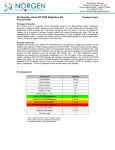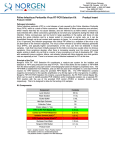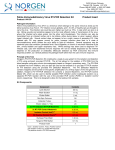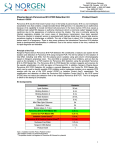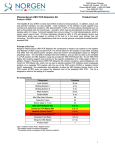Download RSV-A RT-PCR Detection Kit - Protocol
Transcript
3430 Schmon Parkway Thorold, ON, Canada L2V 4Y6 Phone: 866-667-4362 • (905) 227-8848 Fax: (905) 227-1061 Email: [email protected] RSV-A RT-PCR Detection Kit Product Insert Product # 34200 INTENDED USE Norgen’s RSV-A RT-PCR Detection Kit is used for the purification and detection of Human Respiratory Syncytial Virus A (RSV-A) from nasopharyngeal swabs, throat swabs and nasal aspirates from human patients. The kit contains two parts: (1) components to allow for RSV-A RNA purification using Norgen’s proprietary spin column technology, and (2) a ready-to-use detection system for rapid and accurate detection of the RSV-A by end-point RT-PCR. The kit is designed for the rapid extraction and qualitative detection of the nucleocapsid viral RNA transcript of RSV-A in nasopharyngeal swabs, throat swabs and nasal aspirates from human patients with signs and symptoms of respiratory infection in conjunction with clinical and epidemiological risk factors. SUMMARY AND EXPLANATION Respiratory syncytial virus (RSV) is the single most important cause of lower respiratory tract infection during infancy and early childhood worldwide. Both the magnitude and intensity of infection and the host response to RSV infection determine the severity and intensity of disease. Human RSV is a member of the Pneumovirus subfamily of the family Paramyxoviridae. It accounts for approximately 50% of all pneumonia and up to 90% of the reported cases of bronchiolitis in infancy. Outbreaks of RSV disease are abrupt in onset and can last up to 5 months. These epidemics occur annually at regular, predictable intervals. In geographical areas of temperate climate such as the continental United States, RSV activity usually peaks in the winter and extends into the spring. Although the "RSV season" is a predictable annual event, the severity of the outbreaks varies. Fluctuations in the circulating strains of RSV may contribute to the variation seen in the severity of these annual outbreaks. The two major strain groups, A and B, circulate simultaneously during an outbreak, and it has been suggested that group A strains may be associated with more severe disease. The public health problem caused by this virus is exemplified by the fact that approximately two-thirds of infants are infected with RSV in the first year of life; one-third of those infected develop lower respiratory tract disease, 2.5% are hospitalized (more than 90,000 children in the United States every year), and 0.1% die. PRINCIPLES OF THE PROCEDURES Norgen’s RSV-A RT-PCR Detection Kit constituents a ready-to-use system for the isolation and detection of RSV-A using end-point RT-PCR. The kit first allows for the isolation of total RNA, including viral RNA, from nasopharyngeal swabs, throat swabs and nasal aspirates using spin-column chromatography based on Norgen’s proprietary resin. An Isolation control is provided for spike-in isolation for the subsequent determination of extraction efficiency. The viral RNA is isolated free from inhibitors, and can then be used as the template in a RT-PCR reaction for RSV-A detection using the provided RSV-A Master Mix. The RNA is directly added to the provided one-step RT-PCR master mix. The reaction involves first the reverse transcription of the viral RNA into cDNA followed by PCR amplification of the nucleocapsid fragment using a thermo-stable polymerase. An RT-PCR control is provided in all reactions for the determination of RT-PCR efficiency. In addition, a detection control is provided as a positive control for detection. The RT-PCR detection kit is provided with a molecular weight marker for the DNA agarose gel electrophoresis. The detection of the RSV-A virus is determined by the presence of the nucleocapsid specific PCR product, and confirmed by the presence of the Isolation Control product as well as the RT-PCR control product. Kit Components: Component Contents Lysis Solution 30 mL Wash Solution 11 mL Elution Solution 2 mL Mini Spin Columns 24 Collection Tubes 24 Elution Tubes (1.7 mL) 24 RSV-A 2x RT-PCR Master Mix 0..35 mL Control 2x RT-PCR Mastermix 0.35 mL a 0.3 mL Isolation Control (IsoC) b RSV-A Positive Control (PosC) 0.1 mL Nuclease Free-Water 1.25 mL Norgen’s DNA Marker 0.1 mL Product Insert 1 * IsoC = Isolation Control ; PosC= Positive Control a The b The isolation control is a RNA transcript product. positive control is RSV-A RNA transcript Customer-Supplied Reagents and Equipment • Benchtop microcentrifuge • 95-100% ethanol • Thermocycler and or Real-Time PCR System • Micropipettes with an accuracy range between 1-10 µL, 10-100 µL and 100-1000 µL • Laminar flow hood for extractions • Vortex • Sterile, nuclease-free aerosol-barrier micropipettor tips • Microcentrifuge tube rack • Disposable latex gloves • β-mercaptoethanol Storage Conditions and Product Stability • All buffers should be kept tightly sealed and stored at room temperature (15-25oC) for up to 1 year without showing any reduction in performance. • The Positive Control (RSV-A PosC, red cap) and Isolation Control (IsoC, orange cap) should be stored at -70°C. If needed, make aliquots of the controls according to the volume used in the protocol (10 µL of RSV-A PosC or 10 µL of IsoC) prior to freezing. • The RSV-A 2X RT-PCR Mastermix and the Control 2X RT-PCR Mastermix should be stored at -20°C. Make appropriate aliquots if needed • All other kit components may be stored at room temperature • The RSV-A 2X RT-PCR Mastermix, the Control 2X RT-PCR Mastermix, RSV-A Postive Control (PosC) and the Isolation Control (IsoC) should not undergo repeated freeze-thaw (a maximum freeze-thaw of three times). • Allow reagents to thaw at room temperature prior to use • After addition of samples to RT-PCR Master Mix use within one hour General Precautions • Follow universal precautions. All patient specimens should be considered as potentially infectious and handled accordingly. • Diagnostic laboratory work on clinical samples from patients who are suspected of having RSV-A infection should be conducted in a BSL2 laboratory. All sample manipulations should be carried out in a biosafety cabinet. Viral isolation on clinical specimens from patients who are suspected of having RSV-A infection should be performed in a BSL2 laboratory with BSL3 practices. • Wear personal protective equipment, including gloves and lab coats when handling kit reagents. Wash hands thoroughly when finished performing the test. • Do not smoke, drink or eat in areas where kit reagents and/or human specimens are being used. • Dispose of unused kit reagents and human specimens according to local, provincial or federal regulations. • Workflow in the laboratory should proceed in a uni-directional manner, beginning in the preamplification area(s) (i.e. specimen collection and RNA extraction) and moving to the amplification / detection area(s) (RT-PCR and gel electrophoresis). • Do not use supplies and equipment across the dedicated areas of specimen extraction and sample preparation. No cross-movement should be allowed between the different areas. • Supplies and equipment used for specimen preparation should not be used for pipetting or processing amplified DNA or other sources of target nucleic acids. • All amplification supplies and equipment should be kept in the amplification / detection area at all times. • Personal protective equipment, such as laboratory coats and disposable gloves, should be area specific. • As contamination of patient specimens or reagents can produce erroneous results, it is essential to use aseptic techniques. • Pipette and handle reagents carefully to avoid mixing of the samples. • Use proper pipetting techniques and maintain the same pipetting pattern throughout the procedure to ensure optimal and reproducible values. • Do not substitute or mix reagents from different kit lots or from other manufacturers. • Do not interchange reagent tube / bottle caps as this may lead to contamination and compromise test results. • Only use the protocol provided in this insert. Alterations to the protocol and deviations from the times and temperatures specified may lead to erroneous results. Quality Control In accordance with Norgen’s ISO 9001 and ISO 13485-certified Quality Management System, each lot of Norgen’s RSV-A RT-PCR Detection Kit, including the RSV-A 2x RT-PCR Master Mix, Control 2X RT-PCR Master Mix, Isolation Control and RSV-A Positive Control are tested against predetermined specifications to ensure consistent product quality. Product Use Limitations Norgen’s RSV-A RT-PCR Detection Kit is designed for research purposes only. It is not intended for human or diagnostic use. Product Warranty and Satisfaction Guarantee NORGEN BIOTEK CORPORATION guarantees the performance of all products in the manner described in our product manual. The customer must determine the suitability of the product for its particular use. Safety Information Biosafety level 2 practices are recommended for works involving clinical samples from patients who are suspected of having RSV-A infection. Ensure the appropriate containment equipment and facilities are used for activities involving cultures or potentially infectious clinical materials. Ensure that a suitable lab coat, disposable gloves and protective goggles are worn when working with chemicals. For more information, please consult the appropriate Material Safety Data Sheets (MSDSs). These are available as convenient PDF files online at www.norgenbiotek.com. CAUTION: DO NOT add bleach or acidic solutions directly to the sample-preparation waste. The Lysis Solution contains guanidine salts, and should be handled with care. Guanidine salts form highly reactive compounds when combined with bleach, thus care must be taken to properly dispose of any of these solutions. If liquid containing these buffers is spilt, clean with suitable laboratory detergent and water. If the spilt liquid contains potentially infectious agents, clean the affected area first with laboratory detergent and water, and then with 1% (v/v) sodium hypochlorite. INSTRUCTIONS FOR USE Notes Prior to Use • All centrifugation steps are carried out in a benchtop microcentrifuge at 14,000 x g (~ 14,000 RPM) except where noted. All centrifugation steps are performed at room temperature. • A variable speed centrifuge should be used for maximum kit performance. If a variable speed centrifuge is not available a fixed speed centrifuge can be used, however reduced yields may be observed. • Ensure that all solutions are at room temperature prior to use. • Prepare a working concentration of the Wash Solution by adding 25 mL of 95% ethanol (provided by the user) to the supplied bottle containing the concentrated Wash Solution. This will give a final volume of 36 mL. The label on the bottle has a box that may be checked to indicate that the ethanol has been added. • Add 10 µL of β -mercaptoethanol (provided by the user) to each 1 mL of Lysis Solution required. β-mercaptoethanol is toxic and should be dispensed in a fume hood. • It is important to work quickly during this procedure. • Isolation Control (IsoC) • An Isolation Control (IsoC) is supplied. This allows the user to control the DNA isolation procedure. For this assay, add the Isolation Control (IsoC) as indicated during the Lysate Preparation • The Isolation Control (IsoC) must not be added to the sample material directly. • Do not freeze and thaw the Isolation Control (IsoC) more than 2 times. • The Isolation Control (IsoC) must be kept on ice at all times during the isolation procedure. • The PCR components of the RSV-A RT-PCR Detection Kit should remain at -20oC until DNA is extracted and ready for PCR amplification. • It is important to work quickly during this procedure. A. SPECIMEN COLLECTION AND LYSATE PREPARATION Acceptable specimen types include nasopharyngeal swabs, throat swabs or nasal aspirates in viral transport medium tube or equivalent. If using swabs, use only sterile Dacron, nylon or rayon swabs with plastic shafts. Note: Do not use calcium alginate swabs as they may contain substances that are inhibitory to PCR. i. Specimen collection from swab in media: 1) If swab is transported in media the user should transfer 200 µL to an RNase-free microcentrifuge tube. 2) Add 500 µL of the Lysis Solution and vortex for 10 seconds to mix. 3) Add 10 µL of the Isolation Control (IsoC) to the lysate. Vortex for 10 seconds to mix. 4) Add 400 µL of 95% ethanol to the lysate. Vortex for 10 seconds to mix. 5) Proceed to RNA Isolation (Step B). ii. Specimen collection directly from swab: 1) Alternatively, dry swabs can be placed directly into an RNase-free microcentrifuge tube containing 1 mL of the Lysis Solution. 2) Using sterile techniques, cut the tip where the nasal or throat cells were collected and place into microcentrifuge tube containing the Lysis Solution. 3) Close the tube and vortex for 1 minute to release the virus particles. 4) Using a sterile pipette transfer, 400 µL of the lysate into another RNase-free microcentrifuge tube. 5) The Isolation control (IsoC) (10 µL) should then be added to the Lysis tube and the tube vortexed for 10 seconds to mix. 6) Add 200 µL of 95% ethanol to the lysate. Vortex for 10 seconds to mix. 7) Proceed to RNA Isolation (Step B). B. SPECIMEN RNA PURIFICATION Following lysate preparation the viral RNA can be extracted from the patient specimens using the supplied buffers and solutions according to the following protocol: 1. 2. Assemble a column with one of the provided collection tubes. Apply the lysate with ethanol (up to 650 µL) to the column and centrifuge for 1 minute at 14,000 rpm. Note: Ensure the entire lysate volume has passed through into the collection tube by inspecting the column. If the entire lysate volume has not passed through, spin for an additional minute. 3. 4. 5. Discard the flowthrough and reassemble the spin column with its collection tube. Depending on lysate volume, repeat steps B2 and B3 to load entire volume. Apply 400 µL of Wash Solution and centrifuge for one minute at 14,000 rpm. Note: Ensure the entire Wash Solution has passed through into the collection tube by inspecting the column. If the entire wash volume has not passed through, spin for an additional minute. 6. 7. 8. Discard the flowthrough and reassemble the spin column with its collection tube. Repeat steps B5 and B6 two more times. Spin the column for 2 minutes to thoroughly dry the resin at 14,000 rpm. Discard the collection tube. 9. Place the column into a new 1.7 mL Elution tube. 10. Add 50 µL of Elution Solution to the column. 11. Centrifuge for 2 minutes at 2,000 rpm followed by a 2 minute spin at 14,000 rpm. Note the volume eluted from the column. If the entire 50 µL has not been eluted, spin the column for an additional minute at 14,000 rpm. 12. The purified RNA sample could be used immediately for RT-PCR as described below. It is recommended that samples be placed at -70°C for long term storage. C. RSV-A RT-PCR Assay Preparation Notes: • Before use, suitable amounts of all RT-PCR components should be completely thawed at room temperature, gently vortexed and centrifuged briefly. • The amount of RSV-A 2X RT-PCR Master Mix provided is enough for up to 32 RT-PCR reactions (24 sample RT-PCR, 4 positive control RT-PCR and 4 no template control RT-PCR). • For each sample, one RT-PCR reaction using the RSV-A 2X RT-PCR Mastermix and one RT-PCR reaction using Control 2X RT-PCR Mastermix should be set up in order to have a proper interpretation of the results. • For every RT-PCR run, one reaction containing RSV-A Positive Control (RSV-A PosC) and one reaction as no template control (Nuclease Free-Water) must be included for proper interpretation of results. • The recommended minimum number of RNA samples tested per RT-PCR run is 6. • Using a lower volume from the sample than recommended may affect the sensitivity of RSV-A Limit of Detection. 1. Prepare the RT-PCR reaction for sample detection (Set #1, using RSV-A 2X Detection RT-PCR Mastermix) and the RT-PCR reaction for control detection (Set #2, using Control 2X RT-PCR Mastermix) as shown in Table 1 below. The recommended amount of sample RNA to be used is 1 - 2 µL. Ensure that one RSV-A detection reaction and one control reaction is prepared for each RNA sample. Adjust the final volume of the RT-PCR reaction to 20 µL using the Nuclease-Free Water provided. Table 1. RT-PCR Assay Preparation RT-PCR Components Volume Per RT-PCR Reaction RSV-A 2X RT-PCR Master Mix Or Control 2X RT-PCR Master Mix 10 µL Sample RNA 2 µL Nuclease-Free Water 8 µL Total Volume 20 µL 2. For every RT-PCR run, prepare one positive control RT-PCR as shown in Table 2 below: Table 2. RT-PCR Positive Control Preparation RT-PCR Components Volume Per RT- PCR Reaction RSV-A 2X RT-PCR Master Mix Or Control 2X RT-PCR Master Mix 10 µL RSV-A Positive Control (PosC) 10 µL Total Volume 20 µL 3. For every RT- PCR run, prepare one no template control RT-PCR as shown in Table 3 below: Table 3. RT-PCR Negative Control Preparation RT-PCR Components Volume Per RT-PCR Reaction RSV-A 2X RT- PCR Master Mix Or Control 2X RT-PCR Master Mix 10 µL Nuclease-Free Water 10 µL Total Volume 20 µL Therefore, at a minimum, each PCR run will contain 6 separate RT-PCR reaction C. RSV-A One Step RT-PCR Assay Programming 1. Program the thermocylcer according to the program shown in Table 4 below. 2. Run one step RT-PCR. Table 4. RSV-A Assay Program One Step RT-PCR Cycle Step Temperature o Duration Cycle 1 Step 1 50 C 30 min Cycle 2 Step 1 95oC 3 min Cycle 3 (40x) o Step 1 94 C 15 sec Step 2 60oC 30 sec Step 3 Cycle 4 Cycle 5 o 45 sec o 5 min 72 C Step 1 72 C Step 1 o 4C ∞ E. RSV-A RT-PCR Assay Results Interpretation 1. For the analysis of the RT-PCR data, the entire 20 µL RT-PCR Reaction should be loaded on a 1X TAE 1.5% Agarose RNA gel along with 10 µL of Norgen’s RNA Marker (provided). 2. The RT-PCR products should be resolved on the 1X TAE 1.5% Agarose gel at 150V for 20 minutes (Gel running time will be vary depending on an electrophoresis apparatus). 3. Sample results are provided below: M A B C D E F G H I NegC 2000 1500 1000 750 500 300 150 50 Figure 1. Sensitivity of Detection using the Human Respiratory Syncytial Virus A (RSV-A) RTPCR Detection Kit. A representative 1X TAE, 2% agarose gel showing the amplification of the Human Respiratory Syncytial Virus A (RSV-A) at different concentrations (Target). The size of the RSV-A target amplicon corresponds to the 280 bp band represented by the provided DNA Marker (M). Lanes A-I contain decreasing concentrations of RSV-A transcript. Lane H represents a no virus control. 1 2 3 4 5 6 7 8 M Isolation control PCR control Figure 2: A representative 1X TAE 1.5% agarose gel showing the amplification of Isolation Control and PCR Control under different conditions using the Control 2X RT-PCR Mastermix. The size of the Isolation Control amplicon and PCR Control amplicon correspond to 499 bp and 150 bp, respectively, as represented by the provided DNA Marker (M). Lanes 1 to 6 showed detection of both Isolation Control and PCR Control, suggesting that the RNA isolation as well as the RT-PCR reaction was successful. Lane 7 and 8 showed only the detection of PCR Control suggesting that while the RT-PCR was successful, the isolation failed to recover even the spiked-in Isolation control. Table 5. Interpretation of One Step RT-PCR Assay Results Input Type Target reaction Control Reaction Interpretation RSV-A Target Band (280 bp) IsoC Band (499 bp) PCRC Band (150 bp) Positive Control Negative Control X X X X Valid Valid Sample X X X Positive X X Negative X Re-test Sample Sample Sample Re-test Sample X Sample X Sample X Sample X Negative X X Positive Positive Re-test ** For results obtained that are not covered in Table 5 above, please refer to the Troubleshooting Section. F. RSV-A RT-PCR Assay Specificity • The specificity of Norgen’s RSV-A RT-PCR Detection Kit is first and foremost ensured by the selection of the nucleocapsid-specific primers, as well as the selection of stringent reaction conditions. The primers were checked for possible homologies to all in GenBank published sequences by sequence comparison analysis. The specific detectability of all relevant strains has thus been ensured by a database alignment and by PCR amplification with the following commonly found seasonal flu viruses: - Novel Influenza A Virus H1N1 seasonal H1N1 H3N2 Avian H5N1 Influenza B Adenovirus 5 G. RSV-A RT-PCR Assay Specificity • • • The linear range of Norgen’s RSV-A RT-PCR Detection Kit was determined by analysing a dilution series of an RSV-A quantification standard ranging from 1 x 107 copies/µl to 1 x 10-1 copies/µl. Each dilution has been tested in replicates (n = 4) using Norgen’s RSV-A RT-PCR Detection Kit on 1X TAE 2% Agarose gel. The linear range of Norgen’s RSV-A RT-PCR Detection Kit has been determined to cover concentrations from 5 x 103 copies/mL to at least 1 x 109 copies/mL H. Frequently Asked Questions 1. How many samples should be included per RT-PCR run? • Norgen’s RSV-A RT-PCR Detection Kit is designed to test 24 samples. For every 6 samples, a nontemplate control and a Positive Control must be included. It is preferable to pool and test 6 samples at a time. 2. How can I interpret my results if neither the RSV-A PCR control nor the Isolation Control (IsoC) amplifies? • If neither the RSV-A PCR control nor the Isolation Control amplifies, the sample must be re-tested. If the positive control showed amplification, then the problem occurred during the isolation, where as if the Positive control did not amplify, therefore the Problem has occurred during the setup of the PCR assay reaction. 3. How should it be interpreted if only the PCR control showed amplification but neither the RSV-A target nor the Isolation control amplified for a sample? • This indicates a poor isolation. The isolation procedure must be repeated. 4. How should it be interpreted if only the Isolation Control was amplified in a sample? • The sample tested can be considered as RSV-A negative. 5. How should it be interpreted if only the RSV-A target and the PCR control were amplified in a sample? • The sample tested can be considered as RSV-A positive. 6. How should it be interpreted if only the RSV-A PCR control and the Isolation control showed amplification in a sample? • The sample tested can be considered negative 7. What If I forgot to do a dry spin after my second wash? • Your RNA elution will be contaminated with the Wash Solution. This may dilute the RNA yield in your elution and it may interfere with the RT-PCR detection, as ethanol is known to be a PCR inhibitor. 8. What If I forgot to add the Isolation control during the Isolation? • It is recommended that the isolation is repeated. Technical Assistance NORGEN’s Technical Service Department is staffed by experienced scientists with extensive practical and theoretical expertise in sample and assay technologies and the use of NORGEN products. If you have any questions or experience any difficulties regarding Norgen’s RSV-A RT-PCR Detection Kit or NORGEN products in general, please do not hesitate to contact us. NORGEN customers are a valuable source of information regarding advanced or specialized uses of our products. This information is helpful to other scientists as well as to the researchers at NORGEN. We therefore encourage you to contact us if you have any suggestions about product performance or new applications and techniques. For technical assistance and more information, please contact our Technical Support Team between the hours of 8:30 and 5:30 (Eastern Standard Time) at (905) 227-8848 or Toll Free at 1-866-667-4362. or call one of the NORGEN local distributors (www.norgenbiotek.com) or through email at [email protected]. 3430 Schmon Parkway, Thorold, ON Canada L2V 4Y6 Phone: (905) 227-8848 Fax: (905) 227-1061 Toll Free in North America: 1-866-667-4362 ©2013 Norgen Biotek Corp. PI34200-6










